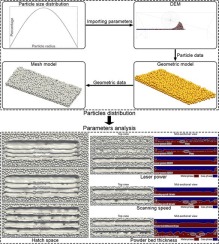当前位置:
X-MOL 学术
›
Comp. Mater. Sci.
›
论文详情
Our official English website, www.x-mol.net, welcomes your
feedback! (Note: you will need to create a separate account there.)
Mesoscopic-scale simulation of pore evolution during laser powder bed fusion process
Computational Materials Science ( IF 3.1 ) Pub Date : 2020-06-01 , DOI: 10.1016/j.commatsci.2020.109686 Liu Cao
Computational Materials Science ( IF 3.1 ) Pub Date : 2020-06-01 , DOI: 10.1016/j.commatsci.2020.109686 Liu Cao

|
Abstract Laser powder bed fusion (LPBF) is an advanced manufacturing technology that uses data-driven, layer-by-layer accumulation of materials to form metal components and has been widely applied in aerospace and other fields. Effectively controlling pore defects is a key scientific problem and technical difficulty in LPBF industrial production. Based on the open-source discrete element method code Yade, the particle distribution of the powder bed was obtained. Based on the open-source computational fluid dynamics code OpenFOAM, the pore evolution during the LPBF formation process at the mesoscopic scale was predicted. The thermal–force factors affecting the molten pool included the surface tension, Marangoni effect, gasification recoil force, and mushy drag force. The laser energy model used a body heat source based on interface tracking. First, dimensionless analysis of the molten pool evolution in the case of LPBF single-track formation was carried out. The molten pool evolution was mainly influenced by the gasification recoil force, Marangoni effect and surface tension, and the main influencing factors on different zones of the molten pool were different. To examine the influences of the laser power, scanning speed, powder bed thickness, and hatch space on the pore defect in the LPBF formation process, simulations were carried out and compared with experimental results. When the volumetric energy density was too small, pore defects occurred due to insufficient fusion of metal particles, and when the volumetric energy density was too large to cause the “keyhole” effect, pore defects occurred because the entrained gas could not escape in time. This paper is expected to provide theoretical guidance for the scientific regulation of pore defects in LPBF production.
中文翻译:

激光粉末床熔融过程中孔隙演化的细观尺度模拟
摘要 激光粉末床融合(LPBF)是一种先进的制造技术,它利用数据驱动的材料逐层堆积形成金属部件,已广泛应用于航空航天等领域。有效控制孔隙缺陷是LPBF工业化生产中的关键科学问题和技术难点。基于开源的离散元法代码亚德,得到粉床的颗粒分布。基于开源计算流体动力学代码OpenFOAM,预测了LPBF形成过程中细观尺度的孔隙演化。影响熔池的热力因素包括表面张力、马兰戈尼效应、气化反冲力和糊状阻力。激光能量模型使用基于界面跟踪的体热源。第一的,在 LPBF 单轨形成情况下,对熔池演化进行了无量纲分析。熔池演化主要受气化反冲力、马兰戈尼效应和表面张力的影响,熔池不同区域的主要影响因素不同。为了研究激光功率、扫描速度、粉床厚度和孵化空间对LPBF形成过程中孔隙缺陷的影响,进行了模拟并与实验结果进行了比较。当体积能量密度过小时,由于金属颗粒融合不充分而产生孔隙缺陷;当体积能量密度过大导致“锁孔”效应时,则由于夹带的气体不能及时逸出而产生孔隙缺陷。
更新日期:2020-06-01
中文翻译:

激光粉末床熔融过程中孔隙演化的细观尺度模拟
摘要 激光粉末床融合(LPBF)是一种先进的制造技术,它利用数据驱动的材料逐层堆积形成金属部件,已广泛应用于航空航天等领域。有效控制孔隙缺陷是LPBF工业化生产中的关键科学问题和技术难点。基于开源的离散元法代码亚德,得到粉床的颗粒分布。基于开源计算流体动力学代码OpenFOAM,预测了LPBF形成过程中细观尺度的孔隙演化。影响熔池的热力因素包括表面张力、马兰戈尼效应、气化反冲力和糊状阻力。激光能量模型使用基于界面跟踪的体热源。第一的,在 LPBF 单轨形成情况下,对熔池演化进行了无量纲分析。熔池演化主要受气化反冲力、马兰戈尼效应和表面张力的影响,熔池不同区域的主要影响因素不同。为了研究激光功率、扫描速度、粉床厚度和孵化空间对LPBF形成过程中孔隙缺陷的影响,进行了模拟并与实验结果进行了比较。当体积能量密度过小时,由于金属颗粒融合不充分而产生孔隙缺陷;当体积能量密度过大导致“锁孔”效应时,则由于夹带的气体不能及时逸出而产生孔隙缺陷。











































 京公网安备 11010802027423号
京公网安备 11010802027423号